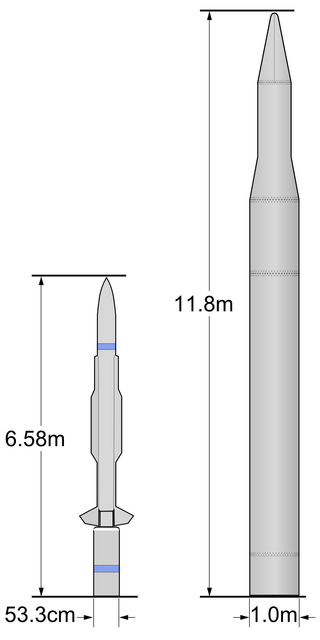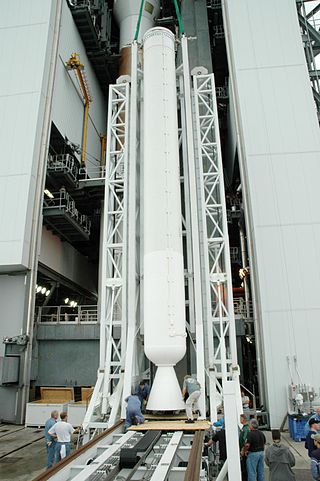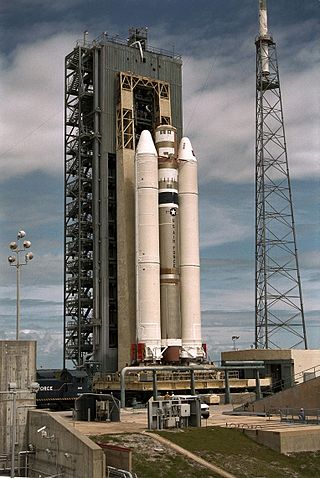
A solid-propellant rocket or solid rocket is a rocket with a rocket engine that uses solid propellants (fuel/oxidizer). The earliest rockets were solid-fuel rockets powered by gunpowder. The inception of gunpowder rockets in warfare can be credited to the ancient Chinese, and in the 13th century, the Mongols played a pivotal role in facilitating their westward adoption.

The XM29 OICW was a series of prototypes of a new type of assault rifle that fired 20 mm HE airbursting projectiles. The prototypes were developed as part of the Objective Individual Combat Weapon program in the 1990s. The term SABR was also used at certain points, but is less common.

Delta II was an expendable launch system, originally designed and built by McDonnell Douglas, and sometimes known as the Thorad Delta 1. Delta II was part of the Delta rocket family, derived directly from the Delta 3000, and entered service in 1989. There were two main variants, the Delta 6000 and Delta 7000, with the latter also having "Light" and "Heavy" subvariants. During its career, Delta II flew several notable payloads, including 24 Global Positioning System (GPS) Block II satellites, several dozen NASA payloads, and 60 Iridium communication satellites. The rocket flew its final mission, ICESat-2, on 15 September 2018, earning the launch vehicle a streak of 100 successful missions in a row, with the last failure being GPS IIR-1 in 1997. In the late 1990s, Delta II was developed further into the unsuccessful Delta III, which was in turn developed into the more capable and successful Delta IV, though the latter shares little heritage with the original Thor and Delta rockets.

Alliant Techsystems Inc. (ATK) was an American aerospace and arms manufacturer headquartered in Arlington County, Virginia. The company operated across 22 states, Puerto Rico, and internationally. ATK revenue in fiscal year 2014 was about US$4.8 billion.
Hydroxyl-terminated polybutadiene (HTPB) is an oligomer of butadiene terminated at each end with a hydroxyl functional group. It reacts with isocyanates to form polyurethane polymers.
Thiokol was an American corporation concerned initially with rubber and related chemicals, and later with rocket and missile propulsion systems. Its name is a portmanteau of the Greek words for sulfur and glue, an allusion to the company's initial product, Thiokol polymer.

The Kinetic Energy Interceptor (KEI) was a planned U.S. missile defense program whose goal was to design, develop, and deploy kinetic energy-based, mobile, ground and sea-launched missiles that could intercept and destroy enemy ballistic missiles during their boost, ascent and midcourse phases of flight. The KEI consisted of the Interceptor Component, the Mobile Launcher Component, and the Command, Control, Battle Management, and Communications (C2BMC) component.

The Graphite-Epoxy Motor (GEM) is a family of solid rocket boosters developed in the late 1980s and used since 1990. GEM motors are manufactured with carbon-fibre-reinforced polymer casings and a fuel consisting of HTPB-bound ammonium perchlorate composite propellant. GEM is produced by Northrop Grumman Space Systems. GEM boosters are used on the Atlas V and were previously used on the Delta II, Delta III, and Delta IV launch vehicles. A new variant, the GEM 63XL, flew as part of the Vulcan Centaur launch vehicle on 8 January 2024.

The Ares V was the planned cargo launch component of the cancelled NASA Constellation program, which was to have replaced the Space Shuttle after its retirement in 2011. Ares V was also planned to carry supplies for a human presence on Mars. Ares V and the smaller Ares I were named after Ares, the Greek god of war.

Ares I was the crew launch vehicle that was being developed by NASA as part of the Constellation program. The name "Ares" refers to the Greek deity Ares, who is identified with the Roman god Mars. Ares I was originally known as the "Crew Launch Vehicle" (CLV).

Athena was a 1990s Lockheed Martin expendable launch system which underwent several name changes in its lifetime.

Castor is a family of solid-fuel rocket stages and boosters built by Thiokol and used on a variety of launch vehicles. They were initially developed as the second-stage motor of the Scout rocket. The design was based on the MGM-29 Sergeant, a surface-to-surface missile developed for the United States Army at the Jet Propulsion Laboratory.
Ammonium perchlorate composite propellant (APCP) is a solid rocket propellant. It differs from many traditional solid rocket propellants such as black powder or zinc-sulfur, not only in chemical composition and overall performance but also by being cast into shape, as opposed to powder pressing as with black powder. This provides manufacturing regularity and repeatability, which are necessary requirements for use in the aerospace industry.

Liberty was a 2011 launch vehicle concept proposed by ATK and Airbus Defence and Space for phase 2 of the NASA Commercial Crew Development (CCDev) program intended to stimulate development of privately operated crew vehicles to low Earth orbit.

Rocket propellant is used as reaction mass ejected from a rocket engine to produce thrust. The energy required can either come from the propellants themselves, as with a chemical rocket, or from an external source, as with ion engines.

AJ-60A is a solid rocket booster produced by Aerojet Rocketdyne. Up to 2020 they were used as strap-on boosters on all United Launch Alliance Atlas V rocket configurations. They continue to be used on the Atlas V N22 configuration used to launch the Boeing Starliner.

Zefiro is a family of solid-fuel rocket motors developed by Avio and used on the European Space Agency Vega rocket. The name Zefiro derives from the acronym ZEro FIrst stage ROcket, conceived when this motor was intended to be used as first and second stages of San Marco program of the Italian Space Agency (ASI). The name also references the Greek god of the west wind, Zephyrus.

The P120C is a solid-fuel rocket motor designed for use as the first stage of the Vega-C and as the boosters of the Ariane 6 launch vehicles. The solid rocket motors were developed by Europropulsion, a joint venture of Avio and ArianeGroup, for the European Space Agency. The "C" in the name signifies its "Common" use across these vehicles.
Tekoi Rocket Test Range, or Tekoi, is a former solid fuel rocket motor test and calibration site operated by Hercules Aerospace near the Utah Test and Training Range in Utah's West Desert, approximately 80 miles (130 km) west of Salt Lake City, Utah. It is located on the Goshute's Skull Valley Indian Reservation.

The Solid Rocket Motor Upgrade (SRMU) was a solid rocket motor that was used as a booster on the Titan IVB launch vehicle. Developed by Hercules, it was intended to be a high-performance, low-cost upgrade to the UA1207 boosters previously used on Titan IV. Wound from carbon-fibre-reinforced polymer and burning a hydroxyl-terminated polybutadiene-bound ammonium perchlorate composite propellant, it was an ambitious upgrade building on Hercules' experience developing a filament-wound case for the Space Shuttle SRB. Originally intended to fly in 1990, it instead first flew in 1997 due to a protracted development and lack of demand. The SRMU performed successfully on all of its flights.
















